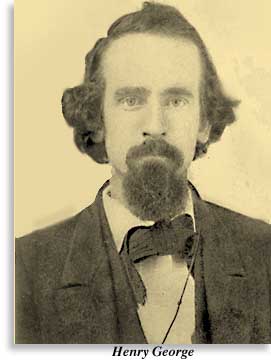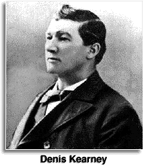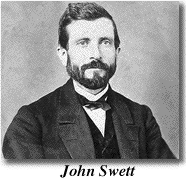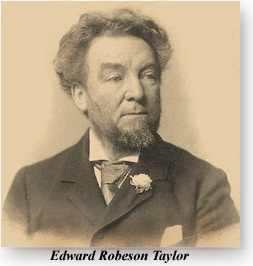
San Francisco History 1865-1900
1888 Biography of Henry George
Preface to 4th Edition, by Henry George
Kearney Agitation in California, by Henry George — 1880
San
Francisco’s Early Labor History
The
Museum’s Labor Archives
John
Swett and Early Calif. Education
Biography
of Andrew Hallidie - Cable Car Inventor
|
Progress and
Poverty—a Paradox
By KENNETH
M. JOHNSON
 HENRY GEORGE intended the
title to his book to state a paradox; however an additional paradox has
developed. This is the fact that in none of the lists of important California
books has the title appeared. One of the earliest and best known selective
listing of California books is Phil Townsend Hanna’s Libros Californianos;
this was first published in 1931 and was reissued with additions in 1958.
In neither edition is there any mention of Progress and Poverty.
The same is true of The Zamorano 80, perhaps the most distinguished
and critical listing of California books to date. The purpose of this article
is to present the book rather than the author or his beliefs, and to indicate
that Progress and Poverty is an interesting, valuable, and important
part of Californiana as well as a Statement of economic theories.
HENRY GEORGE intended the
title to his book to state a paradox; however an additional paradox has
developed. This is the fact that in none of the lists of important California
books has the title appeared. One of the earliest and best known selective
listing of California books is Phil Townsend Hanna’s Libros Californianos;
this was first published in 1931 and was reissued with additions in 1958.
In neither edition is there any mention of Progress and Poverty.
The same is true of The Zamorano 80, perhaps the most distinguished
and critical listing of California books to date. The purpose of this article
is to present the book rather than the author or his beliefs, and to indicate
that Progress and Poverty is an interesting, valuable, and important
part of Californiana as well as a Statement of economic theories.
In the first place the book
was written and printed in California by a Californian. In the library
of his home at 417 First Street, San Francisco, Henry George, who had first
come to California in 1858, began his book on September 18, 1877.1 It
was a culmination of years of economic study and observation, particularly
of the California scene in the 1870’s.
The eighteen-seventies are certainly
one of the most interesting periods in the history of our state as well
as of our country. They were years of strife, stress, and strain on the
labor and political fronts; on the economic side there were panics and
depressions. The Tweed Ring and Tammany Hall were at their strongest; corruption
in high places was the expected thing. Rockefeller, Vanderbilt, Morgan,
and Carnegie were laying the foundation of their fortunes.  In
California, it was the time of the rise of the Workingmen’s Party, Denis
Kearney, and the peak of the anti-Chinese hysteria. It was a period of
contrasts: millionaires were being created from the outpouring of silver
from the Comstock Lode, and millions were being lost through uncontrolled
gambling in Comstock shares. Mansions were being built on Nob Hill, but
there was extensive unemployment. The Bank of California failed. Everyone
knew that the Central-Southern Pacific group completely controlled state
politics, but few knew that the Colton Letters were being written
and would later show the same group buying and selling the members of Congress.
Land was held by a few groups in tremendous acreage. The
Central-Southern
Pacific combination held over eleven million five hundred thousand acres.2
California was forming a new constitution. The period in California has
well been called the “Discontented Seventies.” This then was
the background against which George was writing.3 In
California, it was the time of the rise of the Workingmen’s Party, Denis
Kearney, and the peak of the anti-Chinese hysteria. It was a period of
contrasts: millionaires were being created from the outpouring of silver
from the Comstock Lode, and millions were being lost through uncontrolled
gambling in Comstock shares. Mansions were being built on Nob Hill, but
there was extensive unemployment. The Bank of California failed. Everyone
knew that the Central-Southern Pacific group completely controlled state
politics, but few knew that the Colton Letters were being written
and would later show the same group buying and selling the members of Congress.
Land was held by a few groups in tremendous acreage. The
Central-Southern
Pacific combination held over eleven million five hundred thousand acres.2
California was forming a new constitution. The period in California has
well been called the “Discontented Seventies.” This then was
the background against which George was writing.3
 Writing
proceeded slowly: each paragraph was discussed with a small coterie of
friends. Among these were William Hinton, printer and publisher, John Swett,
best known as the founder of San Francisco’s school system, A. S. Hallidie
of the cable cars, and Dr. Edward Robeson Taylor. Dr. Taylor appears to
have been the closest to George and probably participated to a greater
extent than anyone else. If anyone ever deserved the title of a Renaissance
man it was Dr. Taylor: he was successfully a printer, poet, doctor of medicine,
lawyer, mayor of San Francisco, and dean of the Hastings College of Law
for many years. This group worked together to the end that every thought
was crystal clear and stated in a simple direct manner so that anyone who
could read could understand. The work was finished in the early part of
March, 1879, a few days from the adjournment sine die of California’s
second constitutional convention.4 On March 22, 1879, the manuscript
was sent to D. Appleton & Co. in New York; the reply was:
Writing
proceeded slowly: each paragraph was discussed with a small coterie of
friends. Among these were William Hinton, printer and publisher, John Swett,
best known as the founder of San Francisco’s school system, A. S. Hallidie
of the cable cars, and Dr. Edward Robeson Taylor. Dr. Taylor appears to
have been the closest to George and probably participated to a greater
extent than anyone else. If anyone ever deserved the title of a Renaissance
man it was Dr. Taylor: he was successfully a printer, poet, doctor of medicine,
lawyer, mayor of San Francisco, and dean of the Hastings College of Law
for many years. This group worked together to the end that every thought
was crystal clear and stated in a simple direct manner so that anyone who
could read could understand. The work was finished in the early part of
March, 1879, a few days from the adjournment sine die of California’s
second constitutional convention.4 On March 22, 1879, the manuscript
was sent to D. Appleton & Co. in New York; the reply was:
We have read your MS. on
political economy. It has the merit of being written with great clearness
and force, but is very aggressive. There is very little to encourage the
publication of any such work at this time and we feel we must decline it.5
 At least at that time publishers
were fairly forthright in their rejections. In turn both Harper’s and Scribner’s
were approached; all declined. George then decided to print the work himself,
and Hinton made his plant on Clay Street available. Type in part was actually
set by George, Taylor, and Hinton. The work was commenced in May, 1879,
and was completed in September. The biographers of George say five hundred
copies were printed; Cowan in his Bibliography indicates that there were
about two hundred copies; in any event the edition was quite small. Copies
were sent to various publishers including Appleton & Co.; this led
to a reply that Appleton would publish the book if given the original plates.
The offer was accepted, and the first trade edition appeared in 1880.
At least at that time publishers
were fairly forthright in their rejections. In turn both Harper’s and Scribner’s
were approached; all declined. George then decided to print the work himself,
and Hinton made his plant on Clay Street available. Type in part was actually
set by George, Taylor, and Hinton. The work was commenced in May, 1879,
and was completed in September. The biographers of George say five hundred
copies were printed; Cowan in his Bibliography indicates that there were
about two hundred copies; in any event the edition was quite small. Copies
were sent to various publishers including Appleton & Co.; this led
to a reply that Appleton would publish the book if given the original plates.
The offer was accepted, and the first trade edition appeared in 1880.
After a slow start the book
became a runaway best seller. It was serialized in Lovell’s Magazine,
a sort of Saturday Evening Post of its day. Translations both authorized
and unauthorized began to appear. There have been German, Swedish, Danish,
Norwegian, French, Italian, Spanish, Portuguese, Russian, Bulgarian, Yiddish,
Chinese, Japanese, and Korean editions. In 1960 the book was in print in
English and eight foreign language editions.6 The Robert Schalkenbach
Foundation (organized to promote the economics of Henry George) has tried
to estimate the total number of copies printed but without success, except
to ascertain that the number is in the millions. Alice Hackett in her Fifty
Years of Best Sellers, 1985-1945 indicates sales in excess of three
million. 7 Progress and Poverty entered the list of Random House’s Modern
Library in 1938 and has been selling regularly since.8 In 1942 there
was a printing by the Classics Club (a book subscription organization)
with a Foreword by John Kieran. The book is number 8l in the Grolier Club’s
One Hundred Influential American Books Before 1900.
One can count on the fingers
of one hand the number of treatises on economics printed before 1880 which
are in print today; certainly it may be said that Progress and Poverty
has had a wider circulation and a broader influence than any similar work.
The next questions are why
is it important and why has it lasted, In partial answer to both questions
it should be pointed out that in the minds of many there are certain misconceptions
as to the book’s nature and contents. It is far more than an argument in
support of George’s theories on taxation: it is a pungently written and
searching analysis of the economic difficulties of the times. The classical
economists are challenged and specific remedies proposed. California is
used as an example with particular reference to the large land holdings;
however George goes further and considers the world as a whole and the
histories of all times. This work is important because it represents original
thinking and new approaches to old problems. However, its true importance
is not the correctness or incorrectness of its theories, but the fact that
it has led thousands to think about the economic facts of life and the
problems of good government. In this book multitudes have met for the first
time the terms capital, wages, rent, and interest in their economic sense;
here other thousands for the first time have met the early stalwarts, Malthus,
Mill, Riccardo, Quesnay, and Adam Smith. Progress and Poverty finds
its real significance in the fact that it is a book which has provoked
the minds of men.
The book has lasted because
it is readable; it is a book that one can browse in. George was writing
for the masses and not for the college professors. Apt and sometimes homely
illustrations are freely used to drive home points. However, all of this
leads the reader to the most serious and intricate problems of economics,
politics, and to a limited extent law. Following are a few quotations from
the book which suggest its style and method:
There is a delusion resulting
from the tendency to confound the accidental with the essential—a delusion
which the law writers have done their best to extend, and political economists
generally have acquiesced in, rather than endeavored to expose—that private
property in land is necessary to the proper use of land, and that to make
land common property would be to destroy civilization and revert to barbarism.
This delusion may be likened
to the idea which, according to Charles Lamb, so long prevailed among the
Chinese after the savor of roast pork had been accidentally discovered
by the burning down of Ho-ti’s hut—that to cook a pig it was necessary
to set fire to a house.9
There is a lot in the center of San Francisco to which the common rights
of the people of that city are yet legally recognized. This lot is not
cut up into infinitesimal pieces nor yet is it an unused waste. It is covered
with fine buildings, the property of private individuals, that stand there
in perfect security. The only difference between this lot and those around
it, is that the rent of one goes into the Common School Fund, the rent
of the others into private pockets.10
Taxes which lack the element of certainty tell most fearfully upon
morals. Our revenue laws as a body might well be entitled, “Acts to
promote the corruption of public officials, to suppress honesty and encourage
fraud, to set a premium upon perjury and the subornation of perjury, and
divorce the idea of justice.” This is their true character, and they
succeed admirably.11
A corrupt democratic government must finally corrupt the people, and
when a people become corrupt there is no resurrection. The life is gone,
only the carcass remains; and it is left for the plowshares of fate to
bury it out of sight.12
Political Economy has been called the dismal science, and as currently
taught, is hopeless and despairing. But this, as we have seen, is solely
because she has been degraded and shackled; her truths dislocated; her
harmonies ignored; the word she would utter gagged in her mouth, and her
protest against wrong turned into an indorsement of injustice. Freed, as
I have tried to free her— in her own proper symmetry, Political Economy
is radiant with hope.13
Some may urge that Progress
and Poverty should not be included in any list of California books
because it is neither descriptive nor historical. This is obvious; however
it is only half true. The creation of the book and its contents subjectively
reflect California of the seventies in a manner that pure description could
never achieve. Also in a broad sense it is historical; it is a part and
parcel of the times which has survived. Just as an old menu tells us what
people were eating and the cost of living, Progress and Poverty
tells why the seventies were called discontented.
The first edition is easily
recognizable because it is the only one bearing the date 1879 on the title
page and the only one showing Hinton as the printer. The book was originally
bound in pebble grained cloth and has been noted in purple, brown, red,
and blue colors. Two ornamental blind stamped bands run horizontally across
the covers. Not all of the copies were bound at the printers. Certain of
those sent to publishers were unbound, and this would appear to explain
the fact that there are other bindings which appear to be original but
depart from the binding described. The copies bound by Hinton have the
words “Author’s Edition” on the spine, and the other bindings
seen have not had these words.
Except for a very few minor
word changes, the first edition by Appleton was exactly the same as the
author’s edition. No change was made until the fourth edition when a preface
written by George was added and a quotation preceding a chapter formerly
credited to an Old Play was given its true authorship, Edward R.
Taylor. From this point on there were no revisions, although certain of
the foreign printings were abbreviated.
If ever The Zamorano
80 is supplemented (and life being what it is, it will be), Progress
and Poverty can well be what it is in the Grolier list, number 81.
It seems fitting to close
with a quotation from Dr. Taylor made shortly after George’s death.
When Progress and Poverty
was in process, as upon its completion, it occurred to me that here was
one of those books that every now and then spring forth to show what man
can do when his noblest emotions combine with his highest mentality to
produce something for the permanent betterment of our common humanity;
that here was a burning message that would call the attention of men to
the land question as it had never been called before; and that whether
the message was embodied in an argument of irrefragability or not, it was
yet one that would stir the hearts of millions.14
NOTES
1. Henry George, Jr.,The
Life of Henry George (New York, 1900), p. 289. This work is by George’s
son; and, while it has the usual fault of a biography by a member of the
family, it contains a lot of detail that otherwise would be lost.
2. Robinson, W. W, Land
in California (Berkeley and Los Angeles, 1948), p. 157.
3. Robert Glass Cleland,
A History of California: The American Period (New York, 1926), p.
402 et seq. Cleland’s treatment of this period of California history
is the best noted.
4. George, Jr., Life
of Henry George, p. 307.
5. George, Jr., Life
of Henry George, p. 315.
6. Charles Albro Barker,
Henry George (New York, I955), pp. 379, 423, 531, 596, and 627;
also letter to the writer from the Robert Schalkenbach Foundation. The
work by Barker would appear to be the definitive biography of George: it
is well written and objective.
7. Alice Payne Hackett,
Fifty Years of Best Sellers, 1895-1945 (New York, 1945), p. 124.
8. Letter to writer from
Random House.
9. Henry George, Progress
and Poverty (4th ed., New York, 1881), p. 357.
10. George, Progress
and Poverty, p. 359.
11. George, Progress
and Poverty, p. 374.
12. George, Progress
and Poverty, p. 479.
13. George, Progress
and Poverty, p. 503.
14. George, Jr., Life
of Henry George, p. 308.
KENNETH M. JOHNSON, a vice-president
of the Bank of America, received his baccalaureate and law degrees from
Stanford University. Besides contributing to various legal and historical
journals, Mr. Johnson is the author of The Strange Eventful History
of Parker H. French; of Aerial California: An Account of Early Flight in
Northern and Southern California, 1849 to World War I; and of José
Yves Limantour v. the United States.
The California Historical Society Quarterly
March 1963
Return
to the top of the page.
|